Invisalign™ Clear Braces – Ocala, FL
Seamlessly Straighten Your Smile
Not everyone is born with a movie star smile. Some people’s teeth are simply crooked, rotated, too short, too long, or spaced too far apart. There are many ways to fix these problems, but often, we find that Dr. Weldon can correct them most effectively and efficiently with the help of Invisalign clear braces. To find out how Invisalign in Ocala can help you seamlessly straighten your smile, contact our practice today!
How Invisalign Works
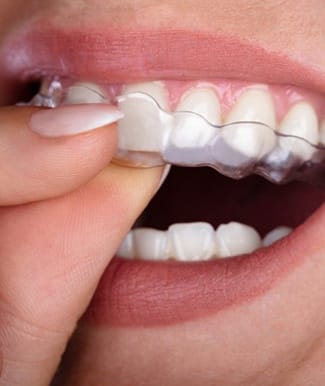
Invisalign uses custom-made aligners that are worn over your teeth. These trays are made of thin, smooth, comfortable, and nearly invisible plastic. The design methodically and gently shifts teeth into proper alignment which is based on the specified movements that Dr. Weldon has determined will correct the teeth. Each set of aligners, which is designed to shift a small portion of your smile, is worn day and night for about two weeks at a time. As your teeth change, you will change to the next pair of Invisalign aligners until your entire smile is perfectly straight.
Who Can Invisalign Help?
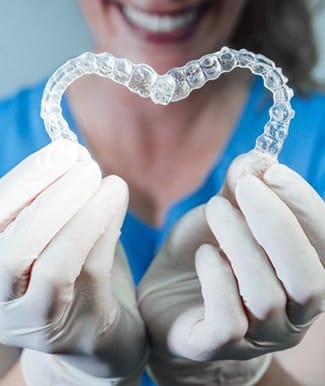
While extreme cases of malocclusion are often best treated with traditional braces, Invisalign can solve several of the most common orthodontic problems, including:
Crowded Teeth
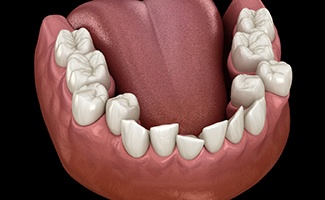
It can be difficult to effectively brush and floss with crowded teeth since they overlap in a way that makes it hard to remove food particles, plaque, and bacteria. In other words, this orthodontic issue can take a toll on your self-esteem and increase your risk of developing cavities and other dental health problems. Fortunately, Invisalign can address overcrowding by strategically shifting your pearly whites into their ideal positions.
Gaps Between Teeth
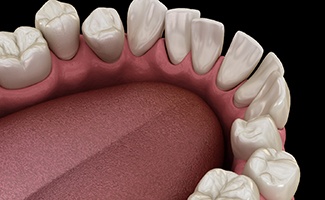
Maybe you aren’t a fan of the noticeable spaces between your teeth, but they don’t bother you enough to get braces. If that’s the case for you, then it’s important to remember that gapped teeth are more than just an aesthetic problem. Food particles can get trapped in significant gaps between teeth, causing bad breath, plaque buildup, and more. Luckily, Invisalign can often close these gaps to promote better oral health and a more attractive, confident grin!
Overbite
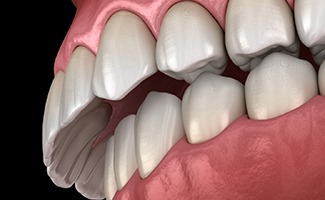
While a slight overbite is normal, a significant overbite is not. In fact, this bite problem can result in numerous consequences, from persistent jaw pain to speech issues. Don’t worry – that doesn’t necessarily mean that you have to wear metal brackets and wires. With the addition of orthodontic accessories, like rubber bands and buttons, clear aligner treatment can move your teeth and your bite into their proper positions.
Underbite
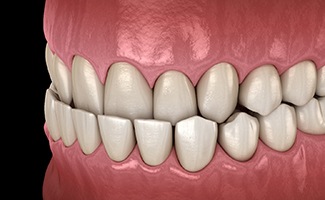
As you may have guessed from the name, an underbite is the opposite problem: your lower teeth jut out beyond the upper ones. Again, this can lead to numerous issues, including low self-esteem, difficulty chewing, chronic jaw pain, and premature wear and tear on your teeth. If you have an underbite and you’re ready to improve the look, health, and function of your smile, then schedule a consultation with us to see if you’re a candidate for Invisalign!
Crossbite
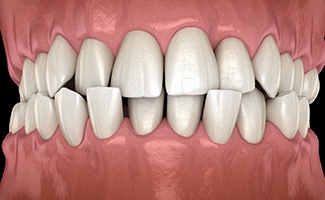
A crossbite is when some of your lower teeth protrude beyond the upper teeth and some of the upper teeth jut out beyond the lower teeth. If you struggle with this bite problem, then you know all too well how difficult it can be to chew properly, enunciate clearly, and smile confidently. Don’t fret – the solution may be more discreet than you think thanks to Invisalign! With the clear aligners and necessary orthodontic accessories, we can often make this orthodontic problem a thing of the past.
Open Bite
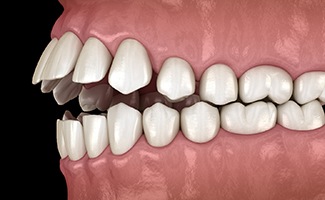
Often the result of genetics or a childhood habit, like thumb-sucking, an open bite is when your teeth don’t come together at the front or back. The main problem with this bite issue is that it can result in premature wear and tear on certain teeth. To prevent that from happening, you need to undergo orthodontic treatment. If you’re a candidate for Invisalign, then we can do so without drawing any unwanted attention to your smile!
Benefits of Invisalign
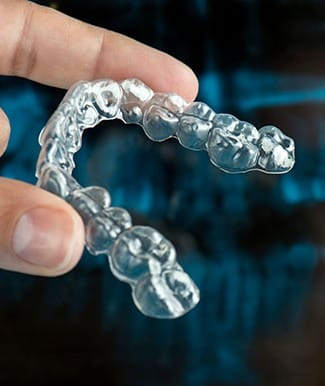
There are other options available to straighten your teeth, but none of those methods offer the level of comfort and esthetics that you can expect with Invisalign. Aside from the obvious visible benefits, here are some advantages of Invisalign over traditional metal braces:
Comfortable Aligners
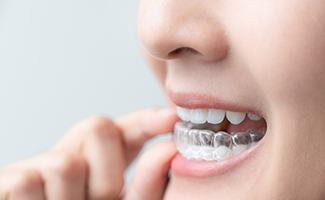
Unfortunately, the sharp edges of traditional braces can irritate the gums, tongue, and cheeks. The good news is that Invisalign doesn’t use metal brackets and wires to straighten your teeth! Instead, a series of custom-made aligners are made from smooth plastic, helping prevent soft tissue irritation in the process.
Note: If you do experience any soft tissue irritation during your teeth-straightening journey with Invisalign, you can always use some dental wax or ask us to file down the edge of your tray.
Hassle-Free Dental Hygiene
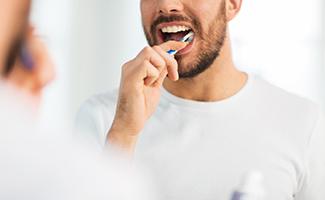
Since your teeth are covered with metal brackets and wires with traditional braces, they are more prone to decay and discoloration, much of which is undetectable until the braces come off. Fortunately, you won’t have to worry about that with Invisalign. Because you can remove the aligners, you’re able to brush and floss as you normally do.
Fewer Follow-Ups
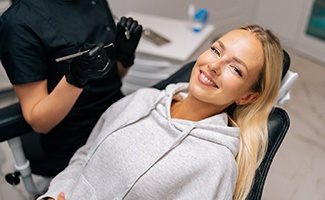
With Invisalign, there aren’t adjustment appointments every four weeks. Instead, you visit us every 6-8 weeks so that we can evaluate your progress. If your teeth are tracking as anticipated, then we will give you the next few pairs of aligners and your visit will be complete! If your teeth aren’t moving, then we will need to make some slight adjustments to your treatment plan before you leave.
Boosted Confidence

The fact that the aligners are clear gets a lot of attention. What many patients don’t realize is that this means no unwanted attention will be drawn to your smile throughout your teeth-straightening journey. In fact, even your coworkers, friends, and family members will have a hard time telling when you’re wearing them! As a result, you’ll be able to smile with confidence every step of the way.
No Dietary Restrictions

One downside of traditional braces is that you need to eliminate certain foods from your diet, like whole apples, raw nuts, and tortilla chips. With Invisalign, you can eat whatever foods you like to enjoy, and you do not have to be concerned with food becoming stuck in braces. Just simply remove the trays before eating and do your best to keep your consumption of sugary and starchy foods to a minimum.
Living with Invisalign Aligners

Have you ever wondered what life with Invisalign actually looks like? If you answered “yes,” then this next section is for you! Below, you’ll find helpful information (plus some bonus tips) on everything from cleaning your aligners to what to do if you accidentally lose them. Of course, if you have any specific questions on the topic, you’re more than welcome to give us a call too!
Wearing Your Trays
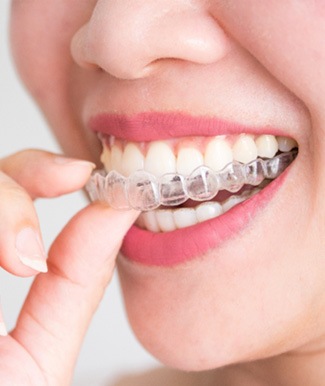
Although the clear aligners do all of the work for you, there is one responsibility you take on when you start Invisalign: you’ll meet the 20-22 hour-a-day wear time. Essentially, this means that you’ll only remove your trays when absolutely necessary, like before eating. If you consistently miss the mark, then your teeth won’t move as anticipated, and you’ll fall off-track with your treatment timeline.
Tip: Use the Invisalign app to make tracking your wear time easy!
Cleaning Your Aligners
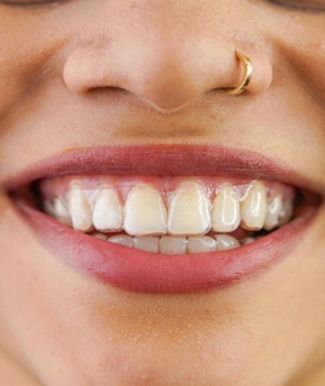
Naturally, you don’t want your clear aligners to turn yellow, brown, or grey. To prevent that from happening, we recommend using clean, lukewarm water and a soft-bristled toothbrush to clean them after each meal. It’s also a good idea to get in the habit of rinsing them thoroughly with clean water each time you remove them.
Tip: Soak your aligners in some lukewarm water and a packet of cleaning crystals for a deeper clean!
Eating & Drinking

Although there aren’t any dietary restrictions, there is one “must” when it comes to eating and drinking: you need to take your aligners out first. If you don’t, then your trays can warp, discolor, and even break into several pieces. So, take them out, rinse them off, and place them in their designated case before breakfast, lunch, dinner, and any snacks.
Tip: Keep sugary foods to a minimum to help prevent tooth decay!
Losing or Damaging a Tray

If one of your trays breaks (even if there is just a small crack) we encourage you to give us a call so we can learn more about your situation and determine if a replacement needs to be made. If you’ve lost your aligners, then do your best to retrace your steps. If you can’t find them, don’t panic. Instead, get in touch with us so we can determine the best way to move forward.
Tip: Place your trays in their case any time you aren’t wearing them!
Routine Check-Ins
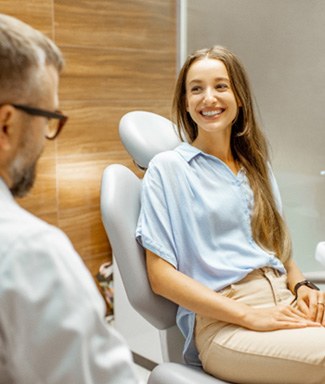
Although you won’t need to come in for adjustment appointments, you will need to come in every six weeks or so for check-in visits. They typically only take 15 minutes or so, but they allow us to take new scans of your teeth and monitor how they are moving in comparison to your treatment plan. If everything looks good, then we will provide you with your next batch of aligners.
Tip: Make sure to wear your current aligners to your appointment!
Understanding the Cost of Invisalign

Because every person’s smile is unique, there is no one-size-fits-all cost for Invisalign clear braces. Each patient’s Invisalign aligners are custom designed to fit their teeth and apply the exact amount of pressure needed to slowly straighten their smile. The final cost of your Invisalign will be influenced by a number of factors. Regardless of its price, our team will help you explore your payment options so you can make a confident decision about whether Invisalign is a fit for your budget.
Factors that Affect the Cost of Invisalign
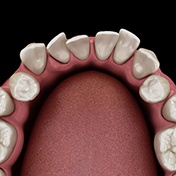
A couple of the primary factors that may affect the cost of Invisalign in Ocala include:
Invisalign VS SmileDirectClub™: Which Costs More?
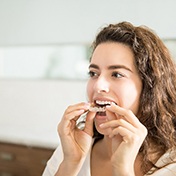
SmileDirectClub™ and similar DIY orthodontic systems have become popular in recent years, mostly because of their low price. They might cost around $2,000, while Invisalign can run anywhere from $3,000 to $8,000. While that is a significant price difference, there is also a significant difference in what you are paying for.
With Invisalign in Ocala, you are paying for a tried-and-true system that uses patented aligner materials and state-of-the-art technology. You have the support of an experienced dentist every step of the way, and good results are almost guaranteed. Conversely, DIY systems often use basic plastic for their aligners, and you usually have to take your own dental impressions. There is a much larger margin for error, and you don’t have personalized professional help from a local dental team. If something goes wrong with your treatment, it may cost thousands of dollars to correct the problem.
Does Dental Insurance Cover Invisalign?

Dental insurance policies vary widely in their approach to Invisalign. Most that cover orthodontics do apply to Invisalign. Your plan might cover half the cost of your treatment, up to the amount of your lifetime orthodontic maximum. Our team will use our insurance expertise to help you figure out whether you can use your policy for Invisalign. We will also file paperwork on your behalf and strive to help you find answers to all of your insurance questions.
Options for Making Invisalign Affordable
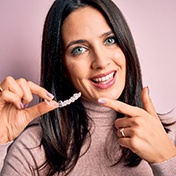
We would like to help you afford Invisalign! That is why, in addition to helping you navigate your insurance, we are also pleased to accept payment from CareCredit. CareCredit is a third-party lender that offers no-interest and low-interest payment plans for medical and dental services. Most patients qualify for it, and you may be able to choose from a variety of plans.
Our team is ready to help you achieve the straight, healthy smile you deserve! We understand that our patients are concerned about the financial aspects of care, and we will do everything we can to help you fit your treatment into your budget.
Invisalign FAQs

Do you want to know more about Invisalign clear braces? Keep on reading! Our knowledgeable staff at Weldon Implant and Cosmetic Dentistry of Ocala has collected some of the most common questions and answers about Invisalign treatment in the handy FAQ section below. Once you have all the facts about this modern alternative to traditional metal braces, you will be ready to schedule an initial consultation with your dentist in Ocala, Dr. Daniel Weldon. Don’t see your specific concern addressed here? Ask Dr. Weldon directly!
How Long Does Invisalign Treatment Take?
The length of Invisalign treatment for your unique smile will depend on a number of factors, including whether you are seeking to address a bite issue or fix a more cosmetic concern like a gap in between your front teeth. In general, most individuals who wear Invisalign clear braces achieve their goal of a straighter smile in just 12 to 18 months! Traditional orthodontic treatment, on the other hand, can often take up to two years or longer. This is just one reason why so many patients are opting for Invisalign in Ocala over metal braces.
How Often Do I Have to Wear My Invisalign Trays?
In order to complete your personalized Invisalign treatment plan on time, it is very important that you wear your aligners for 20 to 22 hours each day. Basically, anytime you are not eating a meal or brushing your teeth, you should have your aligners in place. If you do not wear your Invisalign trays as directed by Dr. Weldon, your teeth will try to shift back to their original positions and your treatment will be delayed.
How Do I Clean My Invisalign Aligners?
Cleaning your Invisalign aligners on a daily basis is critical to preventing plaque and bacteria from building up and potentially harming your teeth. As a best practice, try to clean your aligners every time you brush your teeth – which should be at least twice a day. Here are some Invisalign care tips:
- Hold the aligners in your hand and brush them gently using a soft-bristled toothbrush.
- Toothpaste can sometimes scratch the plastic, so stick to soap and lukewarm water.
- Avoid placing your aligners under hot water, as this can permanently warp the plastic.
- Rinse your aligners with lukewarm water before putting them back into your mouth.
Does My Dental Insurance Cover Invisalign?
Your dental insurance coverage will also have a big influence on the out-of-pocket costs of Invisalign treatment. Many dental insurance plans that cover traditional metal braces also provide coverage for Invisalign. However, every plan is different, so it is important that you double check before committing to Invisalign treatment. If you would like help understanding the particulars of your dental insurance plan, do not hesitate to ask us for assistance! Our experienced staff will be glad to review your insurance coverage and help you maximize your benefits.
Does Invisalign Hurt?
Hands down, one of the most asked questions we get from patients is, “Does Invisalign hurt?” To be honest, some soreness is to be expected, especially when you first start your clear aligner treatment. There is a silver lining though: that means your teeth are moving! Of course, our Ocala dental team will also share our tips and tricks for alleviating any discomfort that does arise, including switching to each new set of trays directly before bed and avoiding hard, crunchy, and sticky foods temporarily.
Is Invisalign Cheaper than Braces?
Since traditional braces and Invisalign are both sought-after, reliable, and effective orthodontic treatments, you might assume that comparing the cost is easy. However, both teeth-straightening services are completely tailored to each patient’s needs, so there isn’t a flat fee to compare. Ultimately, the cost of your Invisalign treatment will depend on important factors like the severity of your misalignment and how well you follow the guidelines, like wearing your aligners for 20+ hours a day.
Can You Eat with Invisalign?
It’s important to remember that while there aren’t any dietary restrictions, you can’t eat with your aligners in. In other words, you can continue your usual diet as long as you remove your trays first. If you don’t, then they will break under the pressure, bringing your treatment plan to an immediate stop.
We also need to mention the importance of eating a well-balanced diet to help keep your teeth and gums healthy. If tooth decay, gum disease, or any other oral health issues develop, then that also has the potential to add weeks or months onto the backend of your treatment. As always, if you have any questions about life with braces, including how to navigate mealtimes, don’t hesitate to ask our team.
Does Invisalign Give You a Lisp?
The short answer is “no.” Basically, your tongue makes a series of precise movements against the back of your teeth to create distinct sounds. So, at the beginning of their clear aligner treatment, some patients experience slight changes to their speaking patterns as their tongue adjusts. If this happens to you, you can rest assured that it’s completely temporary; you won’t have a lisp because of your Invisalign treatment. Plus, there are several ways you can help your tongue adjust, like reading out loud.
What Happens After Invisalign?
Once your teeth are properly aligned, our focus transitions to keeping them there. After all, roughly 50% of patients experience orthodontic relapse, which is when your teeth begin to move back into their misaligned positions. For that reason, we will provide you with a custom-made retainer at the end of your treatment. Sometimes, we ask patients to wear it around the clock for the first few months. Other times, patients are asked to wear it only at night. Ultimately, our recommendation will depend on your specific dental needs.
More to Explore
Teeth Whitening Porcelain Veneers Botox Treatment Facial Fillers See Our Services
Bar

